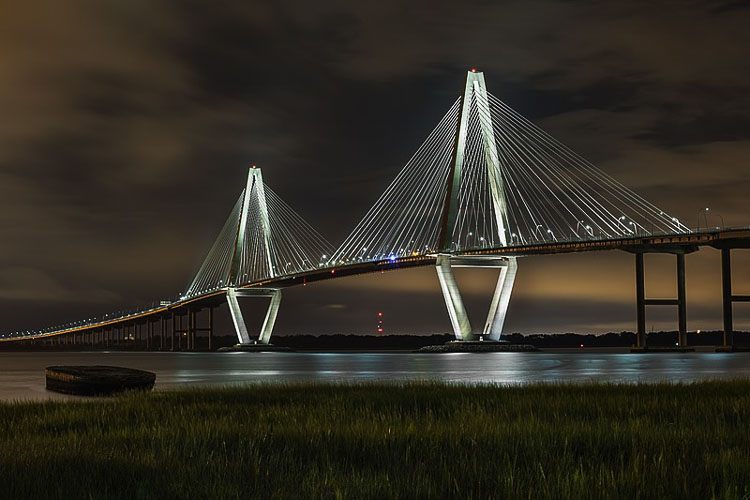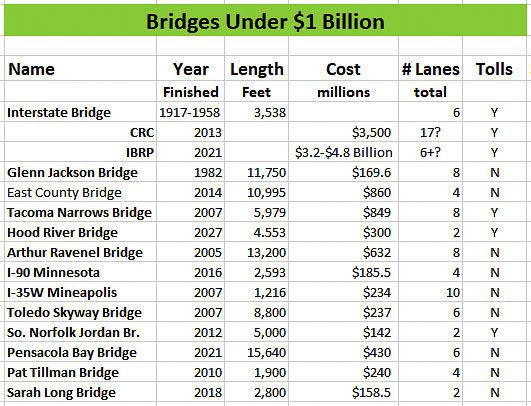CRC bridge was $792 million – under one quarter of $3.5 billion project
Please see editor’s note at bottom of story.
The failed Columbia River Crossing (CRC) was a $3.5 billion project. Forensic accountant Tiffany Couch revealed the actual bridge cost $792 million. Less than one quarter of the cost was for the actual bridge. The current Interstate Bridge Replacement Program (IBRP) expects if the same project was built, the cost could run anywhere from $3.2 billion to $4.8 billion.
The Interstate Bridge is actually two structures, one built in 1917 and the other built in 1958. Both are rated safe by ODOT and WSDOT, yet they do not meet current federal standards for freeways.
The bridge is 3,538 feet long, with its longest span being 531 feet. It provides 72 feet of clearance above the water at the highest point, and 176 feet when the bridge is open.
Part of the CRC’s demise was it’s size. One news report shared the following regarding the impact on Hayden Island. “The CRC plans one of its largest, most expensive and controversial sections across the island’s midsection. The existing freeway is being replaced by a 17-lane behemoth that will stand up to 45-feet high and 450-feet-wide.”
Other failures were the addition of light rail that Clark County did not want, the need for tolls to pay for borrowed money, and the fact the project delivered only a one minute improvement in the morning commute.
Simply put, spending $3.5 billion dollars, plus $2,000 per year in tolls for Clark County residents for a one minute savings in commute time was deemed a bad value. Legislators balked.
The current justification for replacing the bridge is its risk to a Cascadia Subduction Zone seismic event. The IBRP reports a seismic upgrade is too costly and complicated. The bridge therefore must be replaced they say.
What does a bridge cost? Can a bridge be built across the Columbia River for $1 billion or less?
In the aftermath of the CRC failure, Figg Engineering offered in 2014 to build a bridge east of I-205 for under $860 million. The structure would be 10,995 feet long and provide 144 feet of river clearance, matching the height of the I-205 Glenn Jackson Bridge.
The Tacoma Narrows Bridge is in reality two separate bridges, like the Interstate Bridge. The second bridge was constructed in 2007 to address growing traffic demand. It is 5,979 feet long, provides 187.5 feet of clearance below for marine traffic and has eight total lanes.
The new four-lane bridge cost $849 million, part of which was financed with tolls. It carries over 90,000 vehicles a day according to WSDOT. Some of that money went to upgrade the older bridge as well.
The Hood River Bridge across the Columbia River is about to be replaced. It will cost $300 million, have 2 lanes for traffic, one shared bike/pedestrian lane, and is 4,553 feet long. It will have tolls.
The Arthur Ravenel Bridge in Charleston, South Carolina was completed in 2005. WSP USA acted as the primary consultant on that project. IBRP Administrator Greg Johnson came from WSP. WSP has since been hired as the primary consultant for the Interstate Bridge project. (See Editor’s note below story.)
The Charleston bridge is 13,200 feet long, has eight lanes for vehicles, and provides 186 feet of clearance for marine traffic. It was designed to handle 100,000 vehicles each day and includes separate bike and pedestrian facilities. The total cost was $632 million and was finished one year early.
Tolling was discussed but rejected as a means of funding. “We’re not big on tolls,” said Billy Swails, former Mayor of Mt. Pleasant, S.C.

I-90 Mississippi River Bridge in Minnesota was completed in 2016 at a cost of $185.5 million. It is 2,593 feet long and has four lanes, two in each direction. No tolls were used to pay for the construction. Known as the New Dresbach Bridge, it is designed to accommodate a future pedestrian bridge suspended beneath and between the eastbound and westbound structures.
The Minneapolis I-35W bridge is more famous, having collapsed in 2007 due to a design flaw. The Saint Anthony Falls Bridge is 1,216 feet long and was built in 11 months. It has 10 lanes for traffic, provides 70 feet of clearance for marine traffic, and cost $234 million. It carried an estimated 141,000 vehicles daily in 2004 and has no tolls.
The Veterans’ Glass City Skyway, commonly called the Toledo Skyway Bridge, is a cable-stayed bridge on Interstate 280 in Toledo, Ohio. It is 8,800 feet long, offers 130 feet of clearance below for marine traffic, and has six lanes for vehicle traffic. The $237 million bridge was completed in 2007. It was the most expensive project ever undertaken by the Ohio DOT.
The South Norfolk (VA) Jordan Bridge is about 5,000 feet long, offers 145 feet of height for marine traffic and was built completely with private funds. It is part of a state highway and was completed in 2012. Total cost for the 2-lane bridge was $142 million and was privately funded. Presently, $2.65 tolls are paid via EZ Pass to the bridge owners.
The Pensacola Bay Bridge is currently being replaced. It will have six lanes for traffic plus multi-use lanes on each side for pedestrians and bikes, and 65 feet of clearance for marine traffic. The cost is estimated to be $430 million and will not include tolls. It is known as the “3-mile bridge,” for its 15,640 foot length.
The Mike O’Callaghan–Pat Tillman Memorial Bridge is an arch bridge that spans the Colorado River between the states of Arizona and Nevada near the Hoover Dam. It has four lanes of traffic, is 1,900 feet long, and is 890 feet above the water. It was completed in 2010 for $240 million and has no tolls.
The new Sarah Mildred Long Bridge carries the US Route 1 Bypass and a heavy rail line that serves the Portsmouth Naval Shipyard over the Piscataqua River. Coined “three bridges in one,” the crossing consists of vehicular approach bridges stacked over railroad approach bridges leading to a vertical lift span over the navigation channel.
It is 2,800 feet long, only has two lanes for vehicles, but also has a train track below for rail service, and the lift span. The $158.5 million project opened to traffic in March 2018.
What do all these bridges have in common? They cost less than $1 billion to construct. They are all over bodies of water.
Oregon has identified the need to spend $5.1 billion doing seismic upgrades on nearly 1,000 bridges and highways around the state. Seattle is doing extensive repairs to the West Seattle Bridge. It ultimately may need to be replaced. Other transportation needs around the region demand scarce transportation dollars as well.
The Clark County Council has asked to begin planning for a third and fourth bridge and transportation corridors across the Columbia River as part of the IBRP effort. They want a focus on improving traffic congestion, which means new transportation corridors and infrastructure.
Citizens want to save time in their travels, and get value for their transportation dollars.

Editor’s note:
This story has been edited from its original version, which stated: IBRP Administrator Greg Johnson came from WSP, and has hired WSP as the primary consultant for the Interstate Bridge project.
This statement from Frank Green, assistant program administrator, Interstate Bridge Replacement (IBR) program, refutes what was originally stated in Clark County Today’s story: “The process to select the consultant included an evaluation and selection panel consisting of ODOT and WSDOT that also received feedback from program partners. Program Administrator Greg Johnson was specifically excluded from any involvement in the evaluation and selection process to avoid any potential conflict of interest, and he did not have any involvement in the efforts to put together a team to compete for the work during his time at WSP. Proposals for the General Engineering Consultant were due on June 18, 2020, and interviews were held on July 6th, 2020, which was Program Administrator Johnson’s first day on the program that was spent onboarding at ODOT. Documentation of the submittal and selection process is public on the WSDOT Contracting Webpage: https://wsdot.wa.gov/business/consulting/ads/2020-interstate-bridge-replacement-program.”




